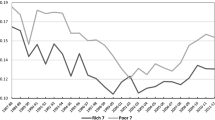Abstract
This paper introduces alternative measures of net budgetallocation and legislative representation. They are neutral tothe size of total expenditure and tax collection as well as tochanges in the population and the size of the legislature,which makes them suitable for panel data exercises andinternational comparative studies. Regression analyses of 50U.S. states and 47 Japanese prefectures using these indiceshighlight similarities and differences in public resourceallocation between respective democracies that reflect theirpolitical and electoral systems.
Similar content being viewed by others
References
Atlas, C.M, Hendershott, R.J. and Zupan, M.A. (1997). Optimal effort allocation by U.S. Senators: The role of constituency size. Public Choice 92: 221-229.
Atlas, C.M, Gilligan, T.W., Hendershott, R.J. and Zupan, M. A. (1995). Slicing the federal government net spending pie:Who wins, who loses, and why.American Economic Review 85: 624-629.
Bennett, J. and Mayberry, E.R. (1979). Federal tax burdens and grant benefits to states: The impact of imperfect representations. Public Choice 34: 255-269.
Biorn, E. (1992). Panel data with measurement errors. In Matyas, L. and Sevestre, P. (Eds.), The econometrics of panel data, 152-195. Dordrecht: Kluwer Academic Publishers.
Buchanan, J.M. and Tullock, G. (1962). The calculus of consent. Ann Arbor: University of Michigan Press.
Fleck, R.K. (2001a). Population, land, economic conditions, and the allocation of New Deal spending. Explorations in Economic History 38: 296-304.
Fleck, R.K. (2001b). Inter-party competition, intra-party competition, and distributive policy: A model and test using New Deal data. Public Choice 108: 77-100.
Grier, K.B, McDonald, M. and Tollison, R.D. (1995).Electoral politics and the executive veto: A predictive theory. Economic Inquiry 33: 427-440.
Meyer. S.A. and Naka, S. (1999). The determinants of Japanese local-benefit seeking.Contemporary Economic Policy 17:87-96.
Meyer, S.A. and Naka, S. (1998). Legislative influences in Japanese budgetary politics. Public Choice 94: 267-288.
Naka, S., Brough, W.T. and Tanaka, K. (1994). The political economy of post-World War II Japanese development: A rent-seeking perspective. In Boettke, P. (Ed.), The collapse of development planning, 256-285. New York: New York University Press.
Wallis, J.J. (2001). The political economy of New Deal spending, yet again: A reply to Fleck. Explorations in Economic History 38: 305-314.
Wallis, J.J. (1998). The political economy of New Deal spending revisited, again: With and without Nevada. Explorations in Economic History 35: 140-170.
Wallis, J.J. (1987). Employment, politics, and economic recovery during the Great Depression. Review of Economics and Statistics 69: 516-520.
Wright, G. (1974). The political economy of New Deal spending: An econometric analysis Review of Economics and Statistics 56: 30-38.
Yonehara, J. (1993). Financial relations between the national and local governments. In Shibata, T. (Ed.), Japan's public sector, 167-178. Tokyo: University of Tokyo Press.
Zupan, M.A. (1991). Local benefit-seeking and national policymaking: Democrats vs. Republicans in the legislature. Public Choice 68: 245-258.
Author information
Authors and Affiliations
Rights and permissions
About this article
Cite this article
Kawaura, A. Public Resource Allocation and Electoral Systems in the U.S. and Japan. Public Choice 115, 63–81 (2003). https://doi.org/10.1023/A:1022841703429
Issue Date:
DOI: https://doi.org/10.1023/A:1022841703429




